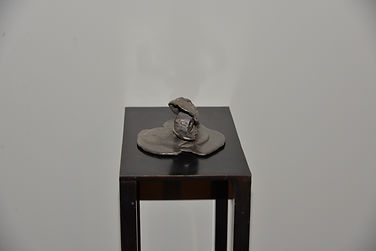Claire Brunet
Claire Brunet is a sculptor who is interested in reflecting the ecological footprint of humans on the environment. Her artistic practice goes beyond just examining the physical aspects of this impact; it delves into the broader influence of our surroundings, and on our identities and actions. Her work serves as a vehicle to contemplate and respond to the complex web of relationships between humans and their environment.
Brunet is preoccupied by the dynamic interplay between time and a creative process that alternates between traditional sculpture processes and 3D and/or virtual technologies, saying: “My creative process embeds a research methodology in which concept and process are intertwined. Temporality and materiality influence the ways in which my work develops inside expanded spatial platforms from real to virtual.”
Brunet’s conceptual approach is blended with a method in which her knowledge of process, materials, and technologies, enabling her the creative freedom to convey the profound impact of humans on the environment in both physical and technological contexts. Her creative research method follows a similar pathway as she moves back and forth between traditional mould-making and casting techniques to 3D scanning and cutting-edge fabrication methods. As she navigates these processes, she bridges the past, present and future. Equally, she sees the ephemerality of being in the now mirrored in how liquid metal transforms matter into ideas.
Brunet’s earlier works from the ’80s include large sculpture Installation works cast in aluminium (Molusma, Ozone: La chaleur trop intense du temps). During the 90’s she created works in which she juxtaposed large photographic images of nature with bronze casts from natural elements found on the actual photographs site. In the 2000s, Brunet featured unexpected bronze replicas from nature, like a pig's head merging out of a tree trunk, its branches laden with pork chops cast in aluminium (A Soul Lost in the Genome). Another series consisted of three cast bronze columns of stacked potatoes (Potato Column I, II & III), each one subtly bearing either two human ears, human eyes, or lips as a commentary on genetic advancements, ethical considerations, and the potential consequences and challenges associated with genetic modification. Larger works are most often supported by, smaller bronze sculptures to further engage a topic, such as the senses: with hands touching leaves (Touch), lips kissing feet (Taste), and the eyes from Michelangelo’s David integrated with branches (Seeing), all imbued with a sense of surrealism.
Brunet challenges the way we perceive the real and the manipulated in a world where the boundary between the two is becoming increasingly blurred and comments on the manipulation of nature, species, and genetics. Art Critic John K. Grande writes: “Brunet’s art can be seen to be a metaphor for the manipulation of nature, of species and genetics, and of our environment, what we are a part of. The raw juxtaposition of nature elements, and what is human that is so endemic to the language and atmosphere her art engenders, asks us to question the great distance we are from nature as the source – both spiritual and physical. Appropriating the real, Claire Brunet’s sculpture replicates a state of being, causing us to reflect on the cause and effect, the relation between human culture and nature which are ultimately inseparable quantities in the same universe.”
Born in London, England, Claire Brunet’s artistic evolution spans various pathways, influences and forms of training, from working with the Quebec Automatiste artist Marcelle Ferron in glass fusion to joining a group of young artists under the mentorship of renowned Canadian sculptor Jordi Bonet. As well, she developed a strong interest in metal casting processes and material transformation, travelling and facilitating the implementation of ceramic shell casting in Europe at the Fonderia Belfiore in Pietra Santa, Italy. Following a B.F.A of Fine Arts from the Université du Québec à Montréal, in the 1980s, Brunet studied at the famous Johnson Atelier in Princeton, New Jersey, where she honed her advanced technological skills in the lost wax process for and interacted with internationally renowned artists, such as Georgia O'Keeffe, Joel Shapiro, and Julian Schnabel who were casting their sculptures at the Johnson Atelier.
Returning to Canada in the mid ‘80s where she set up her own foundry studio, Brunet further brought her knowledge and expertise to OCA (now OCAD U) in the early 1990s, where she is currently Professor in the Sculpture Program. She received her Master of Fine Arts in 1989, and in 2014 a Ph.D. doctorate degree as Doctor of Philosophy Special Individual Program (SIP) Fine Arts from Concordia University, where she researched how new 3D technologies influence the artist’s creative process in sculpture practice (Dissertation Title: Extending Spatial Boundaries through Sculpture Practice: An Exploratory Study of the Influence of a 3D Digital and Technological Context on Sculpture Installation Art).






